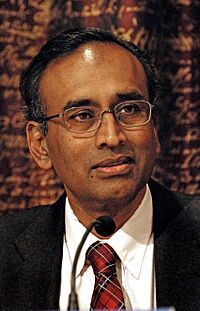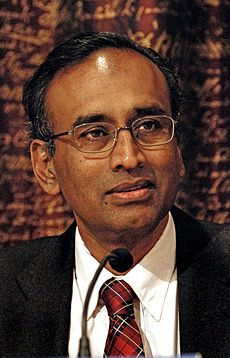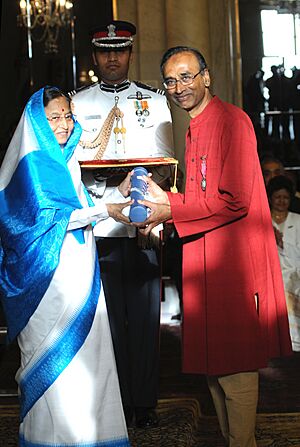Venki Ramakrishnan facts for kids
Quick facts for kids
Venki Ramakrishnan
|
|
|---|---|

Ramakrishnan in 2009
|
|
| 62nd President of the Royal Society | |
| In office 1 December 2015 – 30 November 2020 |
|
| Preceded by | Paul Nurse |
| Succeeded by | Adrian Smith |
| Personal details | |
| Born |
Venkatraman Ramakrishnan
1952 (age 72–73) Chidambaram, Madras State (now Tamil Nadu), India |
| Citizenship |
|
| Spouse |
Vera Rosenberry
(m. 1975) |
| Children | 1 |
| Parent |
|
| Relatives | Lalita Ramakrishnan (sister) |
| Residence | United Kingdom |
| Education |
|
| Known for | |
| Awards |
|
| Scientific career | |
| Institutions | |
| Thesis | The Green Function Theory of the Ferroelectric Phase Transition in Potassium Dihydrogen-Phosphate (1976) |
| Doctoral advisor | Tomoyasu Tanaka |
Venkatraman Ramakrishnan (born in 1952) is a famous British-American scientist who studies the structure of living things. He is often called Venki Ramakrishnan. In 2009, he won the Nobel Prize in Chemistry. He shared this award with two other scientists, Thomas A. Steitz and Ada Yonath. They won for their important work on tiny parts of cells called ribosomes.
Since 1999, he has been a research leader at the Medical Research Council (MRC) Laboratory of Molecular Biology (LMB) in Cambridge, UK. He is also a Fellow at Trinity College, Cambridge. From 2015 to 2020, he was the President of the Royal Society, a very old and respected science organization.
Contents
Early Life and Learning
Venkatraman Ramakrishnan was born in 1952 in a place called Chidambaram in India. His parents, Prof. C. V. Ramakrishnan and Prof. Rajalakshmi Ramakrishnan, were both scientists. His father led the biochemistry department at the Maharaja Sayajirao University of Baroda.
When he was born, his father was in the US doing advanced research. His mother earned her PhD in psychology very quickly in 1959. Venki also has a younger sister, Lalita Ramakrishnan, who is now a professor at the University of Cambridge. She studies how our bodies fight off diseases.
Moving and Schooling
When Venki was three, his family moved to Vadodara in India. He went to school there, except for about a year and a half when they lived in Australia. He studied physics at the Maharaja Sayajirao University of Baroda. He graduated with a Bachelor of Science degree in physics in 1971.
Right after college, he moved to the US. He earned his PhD in physics from Ohio University in 1976. His research was about how certain materials change their properties. After that, he spent two years at the University of California, San Diego. He studied biology there, changing his focus from physics to the study of living things.
Science Work and Discoveries
Venki Ramakrishnan started working on ribosomes as a researcher at Yale University. Ribosomes are like tiny factories inside cells that make proteins. After his research time, it was hard for him to find a permanent job. He applied to many universities but didn't get a faculty position at first.
He kept working on ribosomes from 1983 to 1995 at the Brookhaven National Laboratory. In 1995, he became a professor at the University of Utah. Then, in 1999, he moved to his current job at the Medical Research Council Laboratory of Molecular Biology in England.
Understanding Ribosomes
In 1999, Venki's team published important findings about the ribosome. The next year, they figured out the full structure of a part of the ribosome called the 30S subunit. They also studied how antibiotics work by attaching to ribosomes. This helped scientists understand how proteins are made correctly in cells.
Later, in 2007, his lab created a detailed atomic map of the whole ribosome. This map showed how the ribosome works with other molecules to build proteins. Since 2013, he has used a special technique called Cryogenic electron microscopy. This helps him study how proteins are made in more complex cells. He also did important work on histones and chromatin, which are parts of our DNA.
Leading the Royal Society
Venki Ramakrishnan was the president of the Royal Society from 2015 to 2020. During his time, a big topic was Brexit, which was when the UK decided to leave the European Union. In his last year, the COVID-19 pandemic also happened.
He believed that leaving the European Union was not good for science in Britain. He said it made Britain seem less attractive for scientists. He also argued that science should not be hurt by political disagreements. He felt that working together is key to solving big global problems like climate change and human diseases.
Awards and Special Recognitions
Venki Ramakrishnan has received many awards for his scientific work. In 2002, he became a member of the European Molecular Biology Organization. He was made a Fellow of the Royal Society in 2003. In 2004, he became a member of the U.S. National Academy of Sciences.
In 2007, he won the Louis-Jeantet Prize for Medicine. This is a very important award in medical research. The biggest award came in 2009 when he won the Nobel Prize in Chemistry. In 2010, India gave him its second-highest civilian honor, the Padma Vibhushan.
He has also received special degrees from several universities, including the University of Cambridge. In 2012, he was made a Knight Bachelor by the Queen for his services to science. This means he could use the title "Sir," but he usually doesn't. In 2022, he was given the Order of Merit, a very special honor from the King.
Personal Life
In 1975, Venki Ramakrishnan married Vera Rosenberry. She is an author and illustrator of children's books. He has a step-daughter, Tanya Kapka, who is a doctor. He also has a son, Raman Ramakrishnan, who is a cellist and a professor.
Books Written
Venki Ramakrishnan has also written books about science:
- Why We Die: The New Science of Aging and The Quest for Immortality (2024)
- Gene Machine: The Race to Decipher the Secrets of the Ribosome (2018)
See also
 In Spanish: Venkatraman Ramakrishnan para niños
In Spanish: Venkatraman Ramakrishnan para niños



